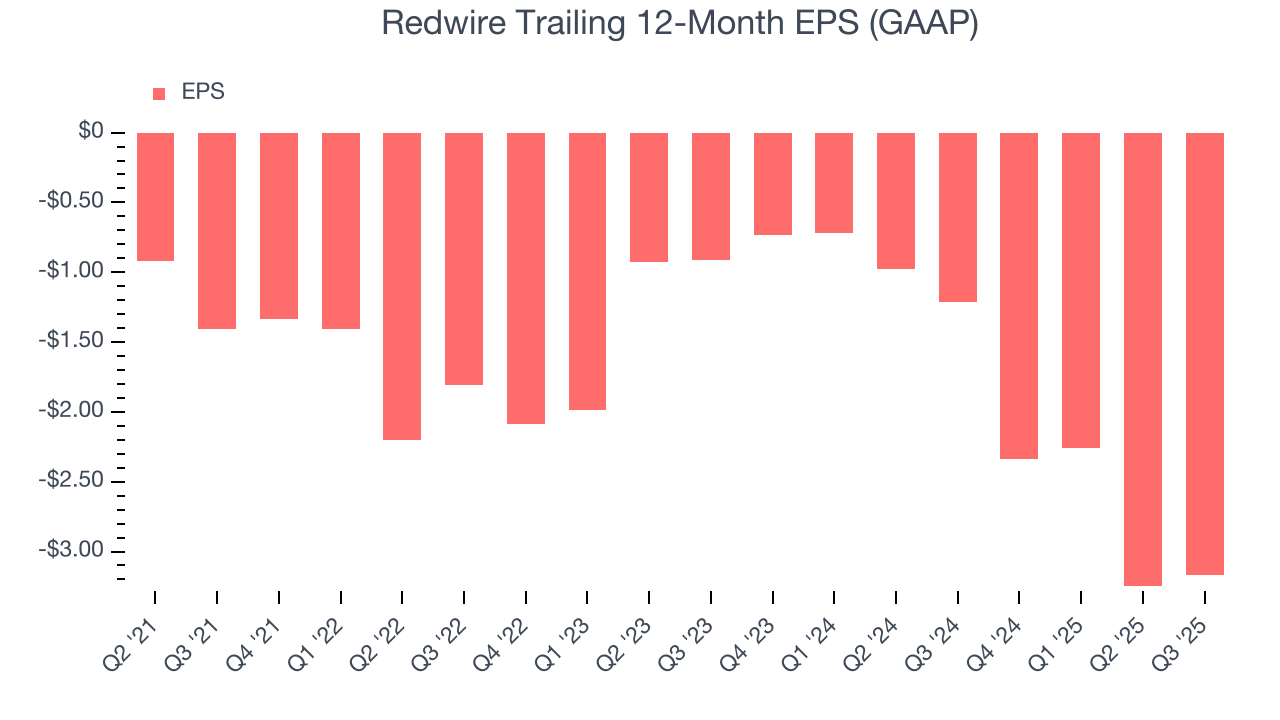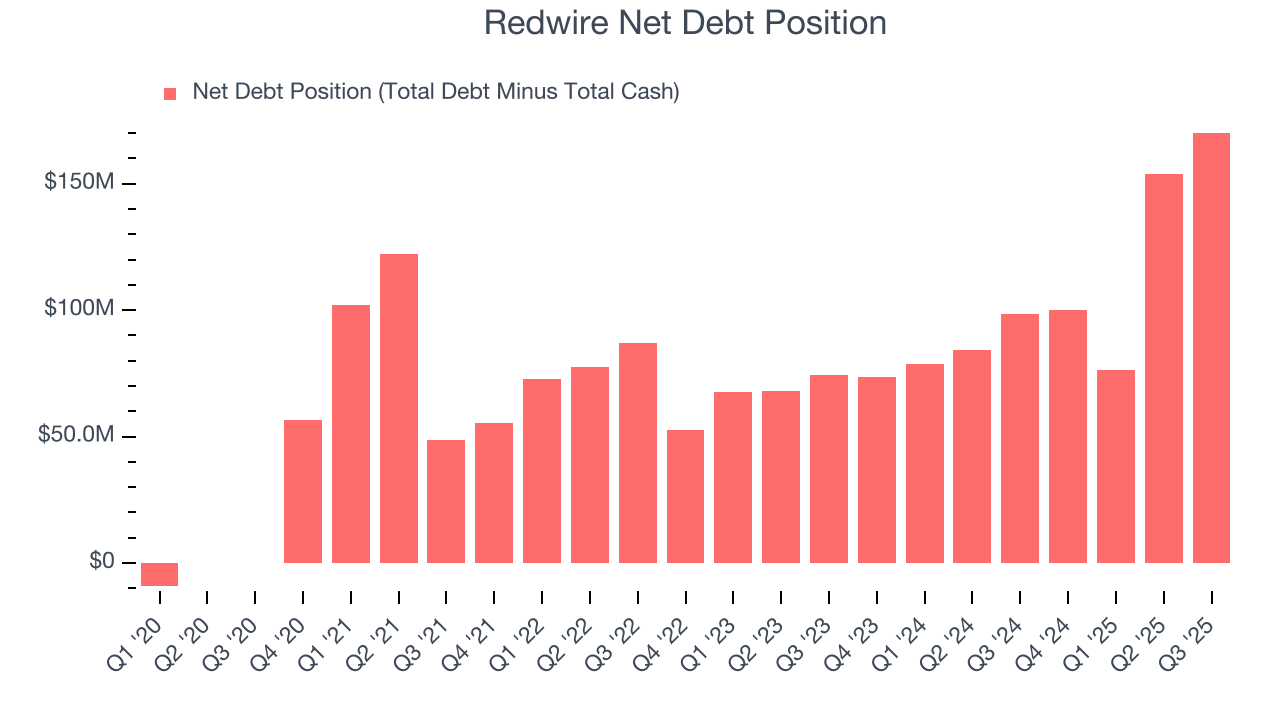
Redwire (RDW)
Redwire is up against the odds. Its poor sales growth shows demand is soft and its negative returns on capital suggest it destroyed value.― StockStory Analyst Team
1. News
2. Summary
Why We Think Redwire Will Underperform
Based in Jacksonville, Florida, Redwire (NYSE:RDW) is a provider of systems and components used in space infrastructure.
- Historically negative EPS casts doubt for cautious investors and clouds its long-term earnings prospects
- Persistent operating margin losses and eroding margin over the last five years point to its preference for growth over profits
- Limited cash reserves may force the company to seek unfavorable financing terms that could dilute shareholders


Redwire doesn’t fulfill our quality requirements. We’re redirecting our focus to better businesses.
Why There Are Better Opportunities Than Redwire
High Quality
Investable
Underperform
Why There Are Better Opportunities Than Redwire
Redwire’s stock price of $5.55 implies a valuation ratio of 31.4x forward EV-to-EBITDA. This multiple rich for the business quality. Not a great combination.
We’d rather pay up for companies with elite fundamentals than get a decent price on a poor one. High-quality businesses often have more durable earnings power, helping us sleep well at night.
3. Redwire (RDW) Research Report: Q3 CY2025 Update
Aerospace and defense company Redwire (NYSE:RDW) fell short of the markets revenue expectations in Q3 CY2025, but sales rose 50.7% year on year to $103.4 million. The company’s full-year revenue guidance of $330 million at the midpoint came in 21.9% below analysts’ estimates. Its GAAP loss of $0.29 per share was 93.3% below analysts’ consensus estimates.
Redwire (RDW) Q3 CY2025 Highlights:
- Revenue: $103.4 million vs analyst estimates of $132 million (50.7% year-on-year growth, 21.7% miss)
- EPS (GAAP): -$0.29 vs analyst expectations of -$0.15 (93.3% miss)
- Adjusted EBITDA: -$2.57 million vs analyst estimates of $8.33 million (-2.5% margin, significant miss)
- The company dropped its revenue guidance for the full year to $330 million at the midpoint from $500 million, a 34% decrease
- Operating Margin: -40.5%, down from -10.8% in the same quarter last year
- Free Cash Flow was -$27.81 million compared to -$19.26 million in the same quarter last year
- Backlog: $355.6 million at quarter end
- Market Capitalization: $1.15 billion
Company Overview
Based in Jacksonville, Florida, Redwire (NYSE:RDW) is a provider of systems and components used in space infrastructure.
Redwire Corporation was established in 2020, following the merger of several companies specializing in space technology and engineering. The company was created to consolidate capabilities in the space sector, focusing on technologies such as in-space manufacturing and robotic systems. Redwire quickly positioned itself as a key provider of infrastructure for space missions, supporting a range of governmental and commercial initiatives.
Today, Redwire provides space systems, including satellite components, robotic systems, and in-space manufacturing capabilities. Its offerings include deployable structures which are used to expand satellite size and function once in orbit, and roll-out solar array (ROSA) systems that unfurl to provide power generation capabilities for spacecraft. They also supply human-rated camera systems designed for operations in space, suitable for capturing high-quality imagery in the harsh space environment. Furthermore, Redwire is at the forefront with robotic assembly technologies, which enable the construction and maintenance of structures while in orbit, enhancing the feasibility of prolonged space missions and habitation.
The company primarily serves space agencies, satellite operators, and firms involved in commercial space activities. It secures long-term contracts with major clients, such as NASA's Archinaut One program, and collaborates closely with the National Security community. Additionally, Redwire's partnerships in the commercial sector are crucial as they navigate the expanding business possibilities in Low Earth Orbit (LEO), exemplified by Virgin Galactic, SpaceX and Blue Origin’s growing offerings of consumer space flights. Revenue streams for Redwire are largely contract based, providing some stability in revenue.
4. Aerospace
Aerospace companies often possess technical expertise and have made significant capital investments to produce complex products. It is an industry where innovation is important, and lately, emissions and automation are in focus, so companies that boast advances in these areas can take market share. On the other hand, demand for aerospace products can ebb and flow with economic cycles and geopolitical tensions, which can be particularly painful for companies with high fixed costs.
Redwire’s peers and competitors include Kratos Defense (NASDAQ:KTOS) and Lockheed Martin (NYSE:LMT).
5. Revenue Growth
A company’s long-term sales performance can indicate its overall quality. Any business can experience short-term success, but top-performing ones enjoy sustained growth for years. Over the last five years, Redwire grew its sales at an incredible 66.6% compounded annual growth rate. Its growth beat the average industrials company and shows its offerings resonate with customers.

We at StockStory place the most emphasis on long-term growth, but within industrials, a half-decade historical view may miss cycles, industry trends, or a company capitalizing on catalysts such as a new contract win or a successful product line. Redwire’s annualized revenue growth of 12.5% over the last two years is below its five-year trend, but we still think the results suggest healthy demand. 
This quarter, Redwire achieved a magnificent 50.7% year-on-year revenue growth rate, but its $103.4 million of revenue fell short of Wall Street’s lofty estimates.
Looking ahead, sell-side analysts expect revenue to grow 87.3% over the next 12 months, an improvement versus the last two years. This projection is eye-popping and indicates its newer products and services will fuel better top-line performance.
6. Operating Margin
Operating margin is a key measure of profitability. Think of it as net income - the bottom line - excluding the impact of taxes and interest on debt, which are less connected to business fundamentals.
Redwire’s high expenses have contributed to an average operating margin of negative 24.4% over the last five years. Unprofitable industrials companies require extra attention because they could get caught swimming naked when the tide goes out. It’s hard to trust that the business can endure a full cycle.
Looking at the trend in its profitability, Redwire’s operating margin decreased by 14.9 percentage points over the last five years. This raises questions about the company’s expense base because its revenue growth should have given it leverage on its fixed costs, resulting in better economies of scale and profitability. Redwire’s performance was poor no matter how you look at it - it shows that costs were rising and it couldn’t pass them onto its customers.

In Q3, Redwire generated a negative 40.5% operating margin.
7. Earnings Per Share
We track the long-term change in earnings per share (EPS) for the same reason as long-term revenue growth. Compared to revenue, however, EPS highlights whether a company’s growth is profitable.
Redwire’s earnings losses deepened over the last four years as its EPS dropped 22.5% annually. We tend to steer our readers away from companies with falling EPS, where diminishing earnings could imply changing secular trends and preferences. If the tide turns unexpectedly, Redwire’s low margin of safety could leave its stock price susceptible to large downswings.

Like with revenue, we analyze EPS over a more recent period because it can provide insight into an emerging theme or development for the business.
For Redwire, its two-year annual EPS declines of 86.6% show it’s continued to underperform. These results were bad no matter how you slice the data.
In Q3, Redwire reported EPS of negative $0.29, up from negative $0.37 in the same quarter last year. Despite growing year on year, this print missed analysts’ estimates. Over the next 12 months, Wall Street expects Redwire to improve its earnings losses. Analysts forecast its full-year EPS of negative $3.17 will advance to negative $0.38.
8. Cash Is King
Although earnings are undoubtedly valuable for assessing company performance, we believe cash is king because you can’t use accounting profits to pay the bills.
Redwire’s demanding reinvestments have drained its resources over the last five years, putting it in a pinch and limiting its ability to return capital to investors. Its free cash flow margin averaged negative 25.5%, meaning it lit $25.49 of cash on fire for every $100 in revenue.
Taking a step back, we can see that Redwire’s margin dropped by 15.1 percentage points during that time. Almost any movement in the wrong direction is undesirable because it is already burning cash. If the trend continues, it could signal it’s in the middle of a big investment cycle.

Redwire burned through $27.81 million of cash in Q3, equivalent to a negative 26.9% margin. The company’s cash burn was similar to its $19.26 million of lost cash in the same quarter last year.
9. Return on Invested Capital (ROIC)
EPS and free cash flow tell us whether a company was profitable while growing its revenue. But was it capital-efficient? Enter ROIC, a metric showing how much operating profit a company generates relative to the money it has raised (debt and equity).
Redwire’s five-year average ROIC was negative 26.4%, meaning management lost money while trying to expand the business. Its returns were among the worst in the industrials sector.

We like to invest in businesses with high returns, but the trend in a company’s ROIC is what often surprises the market and moves the stock price. On average, Redwire’s ROIC decreased by 3.3 percentage points annually over the last few years. Paired with its already low returns, these declines suggest its profitable growth opportunities are few and far between.
10. Balance Sheet Risk
As long-term investors, the risk we care about most is the permanent loss of capital, which can happen when a company goes bankrupt or raises money from a disadvantaged position. This is separate from short-term stock price volatility, something we are much less bothered by.
Redwire burned through $160.6 million of cash over the last year, and its $224.5 million of debt exceeds the $54.33 million of cash on its balance sheet. This is a deal breaker for us because indebted loss-making companies spell trouble.

Unless the Redwire’s fundamentals change quickly, it might find itself in a position where it must raise capital from investors to continue operating. Whether that would be favorable is unclear because dilution is a headwind for shareholder returns.
We remain cautious of Redwire until it generates consistent free cash flow or any of its announced financing plans materialize on its balance sheet.
11. Key Takeaways from Redwire’s Q3 Results
We struggled to find many positives in these results. Its full-year revenue guidance missed and its revenue fell short of Wall Street’s estimates. Overall, this quarter could have been better. The stock traded down 11.8% to $6.44 immediately following the results.
12. Is Now The Time To Buy Redwire?
Updated: December 3, 2025 at 10:53 PM EST
The latest quarterly earnings matters, sure, but we actually think longer-term fundamentals and valuation matter more. Investors should consider all these pieces before deciding whether or not to invest in Redwire.
We see the value of companies helping their customers, but in the case of Redwire, we’re out. Although its revenue growth was exceptional over the last five years, it’s expected to deteriorate over the next 12 months and its relatively low ROIC suggests management has struggled to find compelling investment opportunities. And while the company’s projected EPS for the next year implies the company’s fundamentals will improve, the downside is its declining EPS over the last four years makes it a less attractive asset to the public markets.
Redwire’s EV-to-EBITDA ratio based on the next 12 months is 31.4x. At this valuation, there’s a lot of good news priced in - we think there are better opportunities elsewhere.
Wall Street analysts have a consensus one-year price target of $13.22 on the company (compared to the current share price of $5.55).
Although the price target is bullish, readers should exercise caution because analysts tend to be overly optimistic. The firms they work for, often big banks, have relationships with companies that extend into fundraising, M&A advisory, and other rewarding business lines. As a result, they typically hesitate to say bad things for fear they will lose out. We at StockStory do not suffer from such conflicts of interest, so we’ll always tell it like it is.









